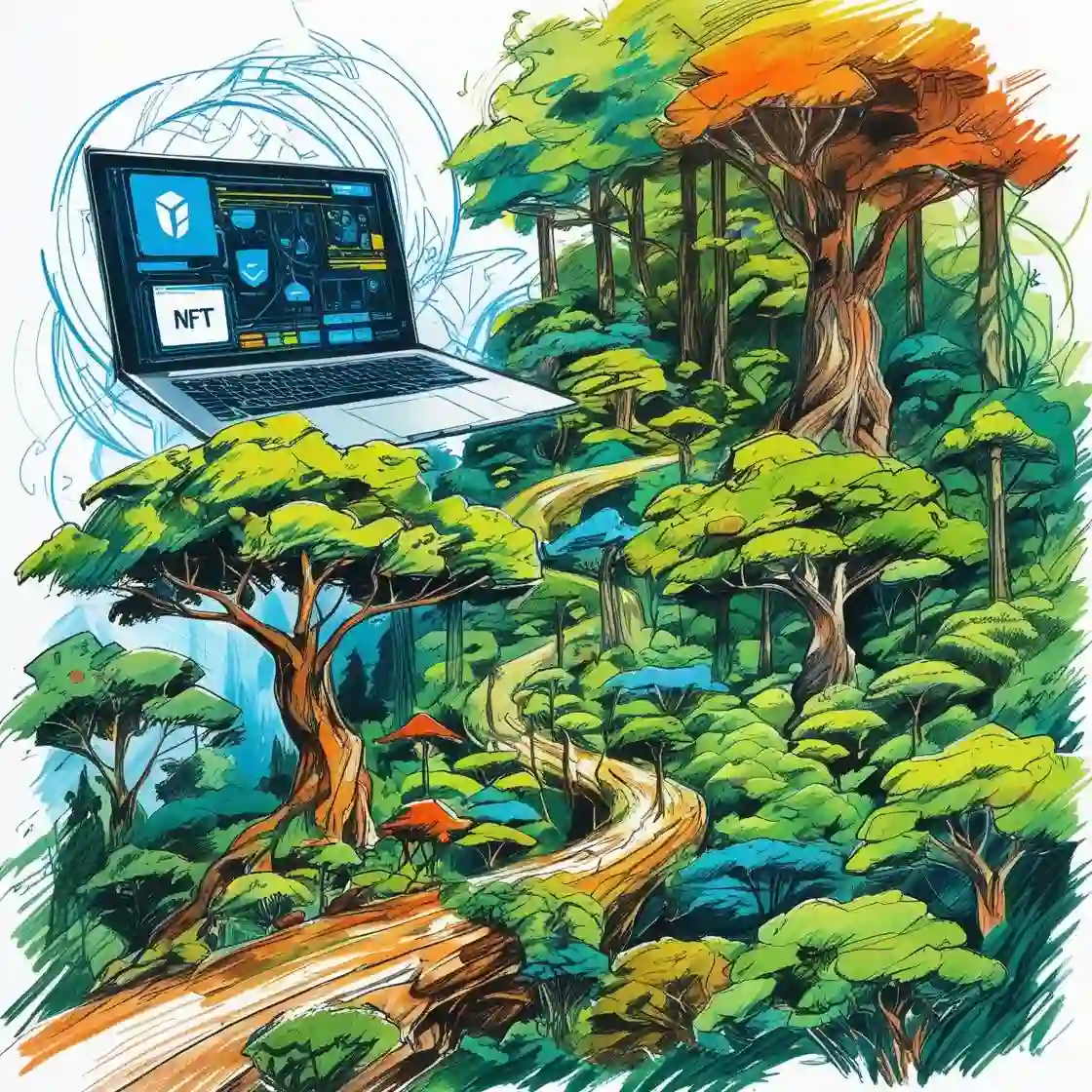How Blockchain Fights Amazon Deforestation Projects JBS and NFT

Every three seconds, the world loses an area of forest the size of a football field. In the Amazon rainforest, this destruction threatens not just trees but the entire planet's climate stability. Yet in this race against time, an unlikely hero has emerged from the digital world: blockchain technology. The same innovation that powers cryptocurrencies is now creating transparent, tamper-proof systems to track deforestation, verify sustainable practices, and fund conservation through revolutionary NFT rainforest conservation projects.
The marriage of cutting-edge technology with environmental protection might seem unexpected, but blockchain deforestation Amazon initiatives are proving that digital solutions can protect physical forests. From JBS's groundbreaking meat traceability platform to innovative NFT projects that let anyone own and protect pieces of the rainforest, blockchain is transforming how we fight deforestation.
Blockchain for Jungle Protection
Innovative blockchain technology initiatives protecting Peru's rainforests through sustainable development
Explore Blockchain SolutionsCommunity-Based Ecotourism
Learn how community-based ecotourism in Peru creates sustainable income while preserving culture and nature
Discover EcotourismThe Amazon Crisis and Blockchain's Promise
The Amazon rainforest, often called Earth's lungs, produces 20% of our planet's oxygen and stores an estimated 150-200 billion tons of carbon. Yet deforestation continues at alarming rates, with Brazil alone losing 13,235 square kilometers of Amazon rainforest in 2020-2021. Traditional conservation efforts, while important, have struggled with corruption, lack of transparency, and insufficient funding.
Enter blockchain technology. Its core features - immutability, transparency, and decentralization - address many challenges that have plagued conservation efforts for decades. When every transaction, every piece of land data, and every conservation commitment is recorded on an unchangeable digital ledger, accountability becomes automatic rather than aspirational.
The potential impact is staggering. Amazon blockchain monitoring systems can track deforestation in real-time, verify carbon credits authentically, and ensure that conservation funds reach their intended destinations without middleman corruption. This isn't theoretical - it's happening now, with major corporations and innovative startups deploying blockchain solutions across the Amazon basin.
JBS Green Platform - Revolutionizing Supply Chain Transparency
The Cattle Industry Challenge
Brazil's cattle industry, with over 214 million head of cattle, has historically been one of the main drivers of Amazon deforestation. The complex supply chains, involving multiple intermediaries between forest and final product, made it nearly impossible to guarantee deforestation-free meat. That's where JBS, the world's largest meat processing company, decided to leverage blockchain technology.
How JBS Green Platform Works
Launched in 2020, the JBS Green Platform uses blockchain deforestation Amazon technology to create an unbreakable chain of custody from farm to fork. Here's how the system revolutionizes meat traceability:
Direct Supplier Monitoring: Every cattle supplier registers on the blockchain platform, providing georeferenced property boundaries, environmental compliance documents, and cattle movement records. This data becomes permanently recorded and cannot be altered retroactively.
Indirect Supplier Integration: The real innovation comes in tracking indirect suppliers - the farms that supply cattle to direct suppliers. By 2025, JBS aims to monitor 100% of its indirect suppliers through blockchain, creating unprecedented supply chain visibility.
Real-Time Verification: The platform cross-references supplier data with satellite imagery and government databases. Any property overlapping with deforestation alerts, indigenous territories, or conservation units is automatically blocked from the supply chain.
Transparent Reporting: All stakeholders, from consumers to environmental groups, can access aggregated data about the supply chain's environmental impact, creating accountability through transparency.
Impact and Results
The numbers speak volumes about the platform's effectiveness:
- Over 15,000 cattle farms now registered on the blockchain system
- 100% of direct suppliers monitored for deforestation compliance
- 50% reduction in documentation processing time
- Zero tolerance for deforestation achieved in monitored supply chains
The platform has already blocked over 14,000 cattle from non-compliant farms, demonstrating that blockchain can enforce environmental standards at scale.
NFT Projects Transforming Forest Conservation
Nemus - Democratizing Rainforest Protection
Nemus has pioneered an innovative approach to NFT rainforest conservation by allowing people worldwide to purchase NFT tokens representing actual areas of the Amazon rainforest. But these aren't just digital collectibles - they're conservation tools with real-world impact.
How Nemus Works:
- Land Acquisition: Nemus purchases or partners with landowners to protect vast areas of Amazon rainforest
- NFT Creation: Each NFT represents a specific GPS-located area, from 1/10 hectare to multiple hectares
- Conservation Commitment: NFT holders don't own the land but become guardians with voting rights on conservation strategies
- Activity Funding: Revenue from NFT sales funds on-ground protection, sustainable development, and local community projects
- Transparency Through Blockchain: All conservation activities and fund usage are recorded on-chain for complete transparency
The project has already protected over 41,000 hectares of rainforest, with NFT holders from 70+ countries participating in Amazon conservation.
Moss - Carbon Credits Meet Blockchain
Moss takes a different approach, focusing on carbon credits and making them accessible through blockchain technology. Their MCO2 token represents one ton of carbon dioxide prevented from entering the atmosphere through Amazon forest preservation.
Moss Platform Features:
| Feature | Description | Impact |
|---|---|---|
| Tokenized Carbon Credits | Each MCO2 token = 1 ton CO2 prevented | 2+ million tons CO2 offset |
| Direct Purchase | Buy carbon credits instantly without intermediaries | 30% cost reduction |
| Project Verification | Blockchain verification of conservation projects | 100% transparency |
| Corporate Integration | Easy API for businesses to offset emissions | 300+ corporate clients |
| Small Purchase Options | Individuals can buy fractions of credits | Democratized access |
Moss has sent over $30 million directly to Amazon conservation projects, protecting an area larger than 1 million football fields.

Peru Politics & Business Impact
In-depth analysis of Peru's political landscape and its effects on business opportunities with future forecasts
Read Full AnalysisPeru Expats Complete Guide 2025
Comprehensive guide covering all pros and cons of living in Peru as an expat - everything you need to know
Explore Expat GuideCAF's O.N.E Amazon Initiative
The Development Bank of Latin America (CAF) launched O.N.E Amazon (Opportunities for Nature and Ecosystems), integrating blockchain technology for comprehensive deforestation monitoring across multiple countries.
Multi-National Coordination
O.N.E Amazon creates a shared blockchain platform where Peru, Brazil, Colombia, Ecuador, and other Amazon nations can:
- Share real-time deforestation data
- Coordinate cross-border conservation efforts
- Track illegal logging and mining activities
- Verify sustainable development projects
Technology Stack
The initiative employs multiple technologies working in harmony:
- Satellite Monitoring: AI analyzes satellite imagery for deforestation patterns
- Blockchain Recording: All alerts and responses are logged immutably
- Smart Contracts: Automatic fund disbursement when conservation goals are met
- IoT Sensors: Ground-based sensors validate satellite data
Benefits of Blockchain for Forest Protection
Transparency and Trust
Blockchain's immutable ledger creates unprecedented transparency in conservation efforts. Every dollar donated, every tree planted, and every hectare protected is recorded permanently. This transparency builds trust among stakeholders who have grown skeptical after decades of failed promises and misused funds.
Eliminating Intermediaries
Traditional conservation funding often loses 30-40% to administrative costs and intermediaries. Blockchain enables direct transfers from donors to conservation projects, ensuring maximum impact for every dollar spent. Smart contracts automatically execute payments when conservation milestones are reached, removing human interference and potential corruption.
Real-Time Monitoring Capabilities
Amazon blockchain monitoring systems provide instant alerts when deforestation is detected. Unlike traditional systems that might take weeks or months to respond, blockchain-enabled platforms can:
- Trigger immediate investigations
- Alert authorities automatically
- Document evidence for legal proceedings
- Coordinate rapid response teams
Advantages of NFT Conservation Models
NFT conservation offers unique benefits:
- Global Participation: Anyone, anywhere can contribute to Amazon conservation
- Emotional Connection: NFT holders feel personal ownership of conservation efforts
- Gamification: Leaderboards and rewards encourage continued engagement
- Transparent Impact: Holders can see exactly how their contribution helps
- Liquidity: NFTs can be traded, creating a conservation-based economy
- Community Building: NFT holders form communities around shared conservation goals
Examples from Peru's Conservation Efforts
Sierra del Divisor National Park
Peru has begun implementing blockchain solutions in Sierra del Divisor National Park, a 1.3 million-hectare protected area bordering Brazil. The system tracks illegal logging attempts and coordinates with Brazilian authorities when criminals cross borders.
Local indigenous communities use simple smartphone apps connected to the blockchain to report suspicious activities. Each report is timestamped and georeferenced, creating legal evidence that has already supported several successful prosecutions.
Madre de Dios Mining Monitoring
In the Madre de Dios region, where illegal gold mining threatens pristine rainforest, blockchain technology tracks the legal gold supply chain. Legitimate miners register their operations on the blockchain, while satellites monitor for new deforestation typically associated with illegal mining.
The system has helped reduce illegal mining by 25% in monitored areas, though challenges remain in areas without internet connectivity.
Community Forest Management
Several Peruvian indigenous communities are piloting blockchain-based forest management systems. These platforms:
- Record traditional knowledge about medicinal plants
- Track sustainable harvesting practices
- Verify fair-trade forest products
- Distribute payments transparently to community members
Early results show increased income for communities while maintaining or improving forest cover, proving that blockchain can support both conservation and development.

Challenges and Solutions
Technical Barriers
Internet Connectivity: Remote Amazon areas often lack reliable internet, limiting blockchain implementation. Solution: Offline-first applications that sync when connected, satellite internet expansion, and mesh networks.
Digital Literacy: Many local communities lack experience with digital technologies. Solution: Simplified interfaces, voice-controlled apps, and extensive training programs in local languages.
Energy Requirements: Blockchain systems require electricity, scarce in remote areas. Solution: Solar-powered nodes, energy-efficient consensus mechanisms, and battery backup systems.
Regulatory Challenges
Different countries have varying regulations about blockchain, cryptocurrency, and digital assets. Creating cross-border conservation systems requires navigating complex legal frameworks.
Progress is being made through:
- Regional cooperation agreements
- Regulatory sandboxes for conservation projects
- Government partnerships with blockchain initiatives
- International standards development
Scalability Concerns
Current blockchain networks can struggle with the volume of data required for comprehensive Amazon monitoring. Solutions being implemented include:
- Layer 2 scaling solutions
- Hybrid on-chain/off-chain architectures
- Specialized conservation blockchains
- Inter-blockchain communication protocols
Future Developments and Potential
Emerging Technologies
The convergence of blockchain with other technologies promises even greater conservation impact:
AI Integration: Machine learning algorithms analyze blockchain-stored data to predict deforestation patterns and optimize conservation strategies.
Drone Networks: Autonomous drones verify on-ground conditions, with findings recorded on blockchain for transparency.
Satellite Tokens: New projects propose launching dedicated satellites for Amazon monitoring, funded through token sales.
Biometric Protection: Some initiatives explore using blockchain to protect indigenous peoples' rights through biometric identification systems.
Expansion Plans
Major developments expected in 2025-2026:
- JBS extending blockchain to all South American operations
- Nemus targeting 100,000 hectares under protection
- Moss launching corporate sustainability platforms
- Peru announcing national blockchain conservation strategy
- Brazil integrating blockchain into official deforestation monitoring
Investment and Funding Trends
Blockchain conservation projects have attracted significant investment:
- Over $200 million raised by major projects in 2024
- Traditional conservation organizations launching blockchain initiatives
- Government grants supporting blockchain conservation research
- Carbon credit markets increasingly moving to blockchain
The Human Impact - Stories from the Ground
Maria's Sustainable Farm
Maria, a small cattle rancher near Porto Velho, Brazil, joined the JBS Green Platform in 2023. "At first, I was skeptical about this blockchain thing," she admits. "But now I get premium prices for my sustainable beef, and buyers trust that my farm doesn't contribute to deforestation. The technology proved what I've been doing right all along."
The Guardian NFT Holders
Tom from London and Yuki from Tokyo have never met, but they co-own an NFT representing one hectare of Amazon rainforest through Nemus. They participate in monthly virtual meetings with local communities, vote on conservation strategies, and receive regular updates with photos and biodiversity reports from their protected area.
"It's incredible," Tom explains. "I'm sitting in London, but I'm actively protecting a piece of the Amazon. The blockchain shows exactly how our funds are used, from paying local guards to funding education programs."
Indigenous Empowerment
The Asháninka people of Peru use blockchain to document their traditional ecological knowledge and sustainable forest management practices. Chief Benki Piyãko explains: "For generations, we've protected this forest. Now, blockchain helps us prove it to the world and receive fair compensation for our conservation work."
Conclusion - Your Role in the Blockchain Conservation Revolution
The fusion of blockchain technology with Amazon conservation represents one of the most promising developments in environmental protection. From JBS's supply chain transparency to NFT rainforest conservation projects like Nemus and Moss, blockchain deforestation Amazon initiatives are proving that technology can be a powerful force for nature.
But technology alone isn't enough. These platforms succeed because people like you choose to participate. Whether you're a company looking to verify sustainable supply chains, an individual wanting to offset your carbon footprint, or someone passionate about protecting the Amazon, blockchain conservation projects offer transparent, effective ways to make a real difference.
The choice is clear and the time is now. Visit platforms like Nemus to explore NFT conservation opportunities. Investigate Moss for accessible carbon credit purchases. Support companies using blockchain for sustainability. Every action, recorded immutably on the blockchain, becomes part of the permanent record of humanity's fight to save the Amazon.
The Amazon rainforest doesn't have time for us to perfect these technologies - it needs action now. Blockchain provides the transparency, efficiency, and global reach necessary to scale conservation efforts to match the magnitude of the threat. By participating in these initiatives, you're not just supporting conservation; you're pioneering a new model for environmental protection that could save forests worldwide.
The question isn't whether blockchain can help save the Amazon - it's already doing so. The question is: will you be part of this conservation revolution?
Frequently Asked Questions
How does blockchain actually prevent deforestation?
Blockchain doesn't directly stop chainsaws, but it creates transparent, tamper-proof systems that make illegal deforestation harder to hide and easier to prosecute. It tracks supply chains so companies can't unknowingly buy products from deforested areas, enables real-time monitoring and reporting, and ensures conservation funds reach their intended purposes without corruption.
Are NFT conservation projects legitimate or just digital speculation?
Legitimate NFT conservation projects like Nemus and Moss are backed by real land and verified conservation activities. They use NFTs as a tool for fundraising and engagement, not speculation. Always verify that projects have legal land rights, transparent use of funds, and partnerships with recognized conservation organizations.
How can I verify that my contribution through blockchain actually protects forests?
Blockchain's transparency allows you to track your contribution's impact. Look for projects that provide GPS coordinates of protected areas, regular satellite imagery updates, on-chain records of all transactions and activities, third-party audits and certifications, and engagement with local communities.
What's the environmental impact of blockchain technology itself?
While some blockchains consume significant energy, most conservation projects use energy-efficient networks like Polygon or Algorand. The carbon saved through prevented deforestation far exceeds the carbon footprint of running these blockchain systems. Many projects also offset their own emissions.
Can small contributions really make a difference?
Absolutely. Blockchain enables micro-contributions that add up to significant impact. For example, a $50 NFT purchase might protect 1/10 hectare of rainforest forever, $10 in carbon credits offsets about half a ton of CO2, and small amounts support local communities managing forests. The transparency ensures even small contributions are used effectively.
Sources and Further Reading
-
JBS Green Platform Official Site https://jbs.com.br/en/greenplatform/
-
Nemus NFT Conservation Project https://nemus.earth
-
Moss Carbon Credit Platform https://moss.earth
-
CAF Development Bank - O.N.E Amazon Initiative https://www.caf.com/en/currently/news/
